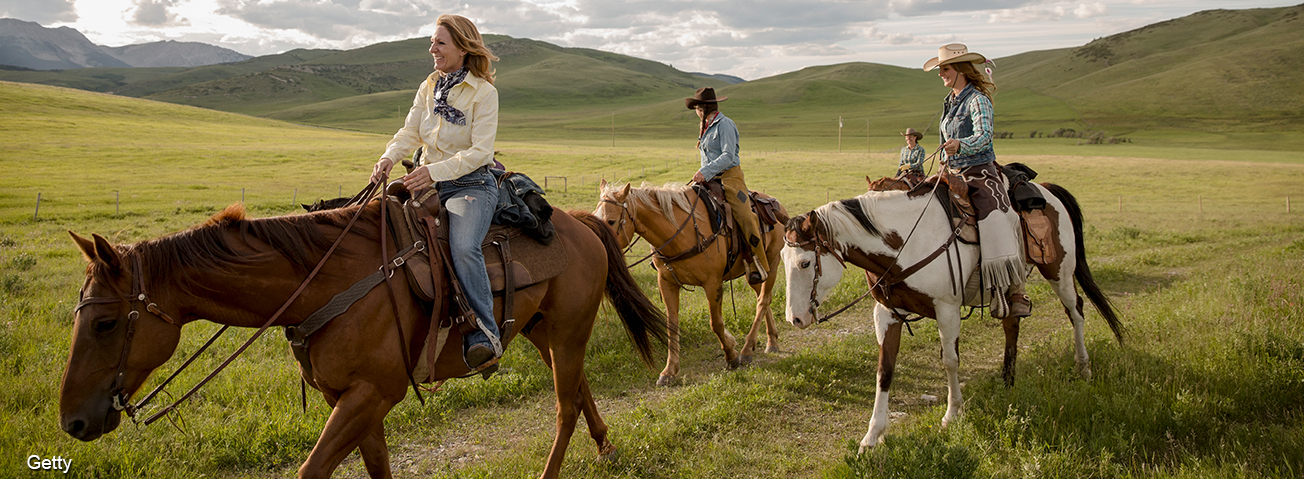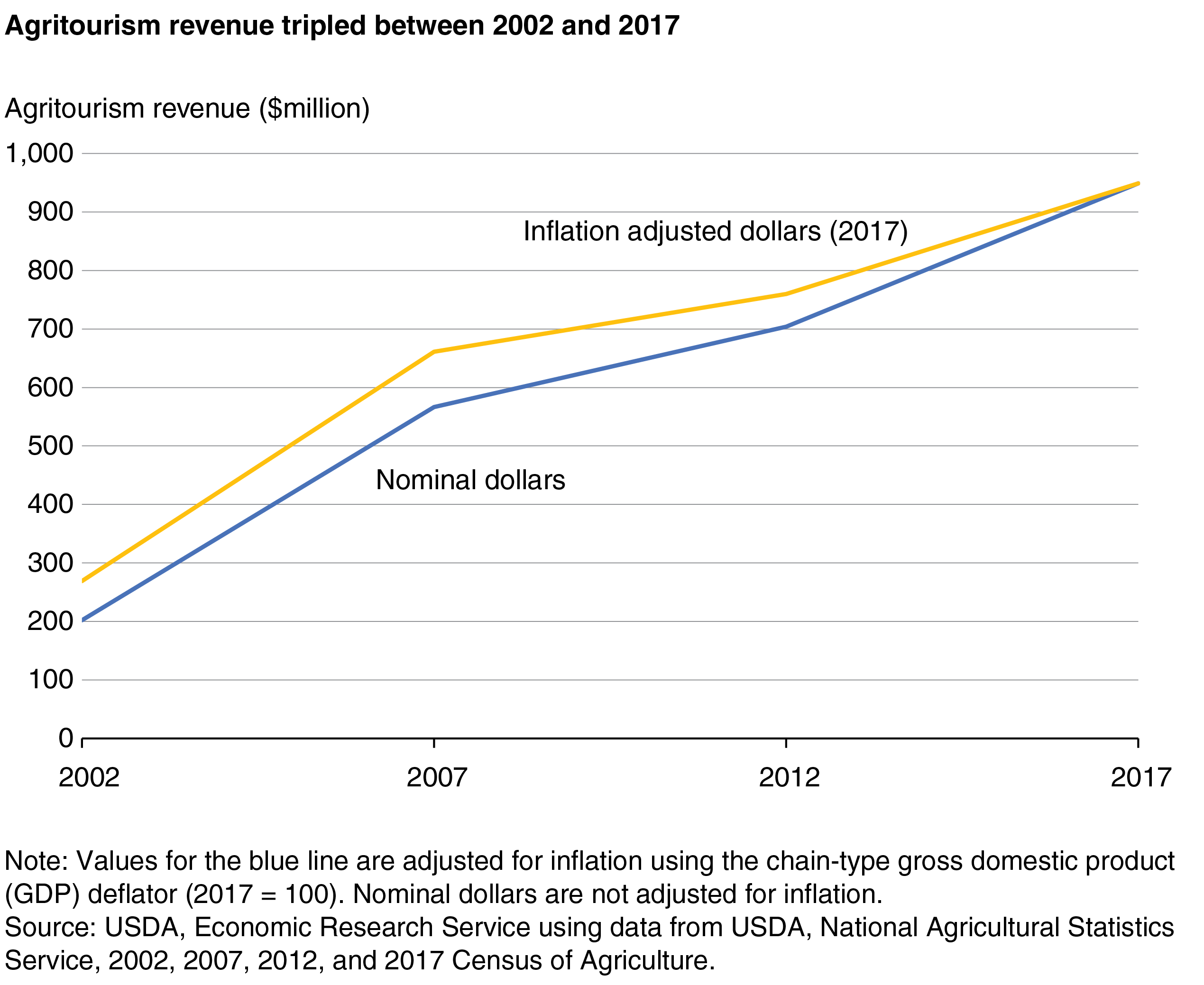
Agritourism Allows Farms To Diversify and Has Potential Benefits for Rural Communities
- by Christine Whitt, Sarah A. Low and Anders Van Sandt
- 11/4/2019
Highlights
- Agritourism—farms that contain a recreational or educational enterprise component, such as tours of a working farm and pick-your-own fruits—are clustered in western Texas, the intermountain West, and some coastal areas.
- Female operators, older operators, and those operating large ranches with cattle or horses (dude ranches specializing in tourist activities, such as camping and horseback riding) are most likely to have agritourism income.
- Farms in remote rural areas are more likely to participate in agritourism, but smaller farm operations seldom report significant agritourism revenue; in contrast, agritourism farms close to urban areas tend to have higher agritourism revenue.
Agritourism helps U.S. farmers and ranchers generate revenue from recreational or educational activities, such as tours of a working farm or “pick-your-own fruits and vegetables” programs. Beginning and small and mid-size farms are increasingly exploring agritourism as a strategy to remain competitive. Agritourism also has the potential to help revitalize rural economies, educate the public about agriculture, and preserve agricultural heritage. In addition, community-focused farms may find agritourism an attractive option because it provides more labor opportunities for local residents.
Farm agritourism revenue more than tripled between 2002 and 2017, according to data from the Census of Agriculture. Adjusted for inflation, agritourism revenue grew from $704 million in 2012 to almost $950 million in 2017. The 2017 data excluded wineries, although they were included in the 2002, 2007, and 2012 data, which suggests agritourism revenue growth may have been even greater during that period. However, agritourism revenue is still small relative to total farm revenue, accounting for 5.6 percent of farm-related income in 2017.
Although many factors affect an operator’s decision to adopt agritourism, ERS researchers identified farm and regional characteristics associated with higher agritourism revenue. Being located near natural amenities or in close proximity to other outdoor activities had a statistically significant positive impact on agritourism economic activity.
Farms and ranches in more populated counties also earned more revenue, although farms in less populated counties were more likely to adopt agritourism. This may be due to expanded marketing opportunities in more populated areas, whereas farms in more rural areas may be adopting agritourism due to fewer perceived alternative sources of income. For example, farms near urban areas also have higher local food sales, all else being equal.
Lastly, certain types of crop and livestock production—specifically, grapes, fruit and tree nuts, and specialty livestock farms—had a positive and statistically significant impact on agritourism revenue. Those types of farms involve multiple opportunities for human interaction and visitor engagement, which attract more visitors.
What Drives Agritourism Adoption
Researchers found several farm-level factors associated with agritourism enterprises. Female operators were more likely to participate in agritourism, particularly on larger agritourism farms. Older operators were slightly more likely to adopt agritourism than younger farmers, all else being equal. In addition, farms and ranches that processed or sold food for human consumption, such as participating in local or regional food systems, were also more likely to adopt agritourism. Direct-to-consumer marketing (such as farmers markets) and direct-to-retail food sales (such as selling to restaurants) provide free marketing for agritourism enterprises through word of mouth. Lastly, farms and ranches with cattle and horses had a greater likelihood of implementing agritourism. Horses in particular are associated with higher value agritourism enterprises, such as dude ranches (ranches specializing in tourist activities, including camping and horseback riding).
Regional drivers of agritourism participation include a county’s entrepreneurial spirit, as measured by proxy variables including the nonfarm self-employment rate and patenting rate. This suggests that nonfarm and farm entrepreneurship are likely linked in rural areas. Results also suggest some locations may provide greater opportunities than others in adopting agritourism based on regional assets, travel infrastructure, and already-established related sectors. Counties with high agritourism activity may benefit from industry concentration, likely an effect of well-established regional reputations. For example, visitors are more likely to visit known wine regions or agritourism farms near scenic byways in the county.
Researchers identified clusters of agritourism with a statistical method that groups counties with a high share of farms involved in agritourism. These clusters were identified as “hot spots,” while groups of counties with low shares of agritourism farms were identified as “cold spots.” Agritourism hot spots adjacent to coastal urban centers were dominated by small farms. Dude ranch agritourism was also found in the intermountain West near natural amenities, such as national parks. Finally, a large hot spot in western Texas was driven primarily by hunting recreation. On the other hand, cold spots were predominantly in the Midwest. These patterns of agritourism differed with climate, culture, and landscape.
The Future of Agritourism
As the share of farms and ranches with agritourism revenue increases, more farmers and ranchers may be encouraged to adopt agritourism activities. Previous research has documented the loss of small and mid-sized farms and ranches, so agritourism revenue may offer a viable strategy to keep these farms afloat—particularly near agritourism hot spots.
Future research could help identify agritourism best practices, keys to success, or barriers to growth. Tracking agritourism operations over time would help researchers better understand the characteristics of successful operations and why some enterprises have chosen to participate in agritourism. Future research could also help identify the rural economic development benefits of industry agglomeration and how they vary based on the type of agritourism enterprise, regional location attributes, and spillovers from other local industries.
This article is drawn from:
- Van Sandt, A., Low, S., & Thilmany, D. (2018). Exploring Regional Patterns of Agritourism in the U.S.: What's Driving Clusters of Enterprises? . (2017). Agricultural and Resource Economics Review, 47(3), 592-609. doi:10.1017/age.2017.36.
- Van Sandt, A., Low, S., Jablonski, B. R., & Weiler, S. Place-Based Factors and the Performance of Farm-Level Entrepreneurship: A Spatial Interaction Model of Agritourism in the U.S. . (2019). Review of Regional Studies, 49.
You may also like:
- Burns, C. & Kuhns, R. (2016). The Changing Organization and Well-Being of Midsize U.S. Farms, 1992-2014. U.S. Department of Agriculture, Economic Research Service. ERR-219.



